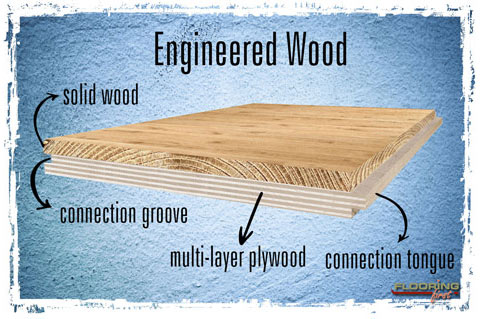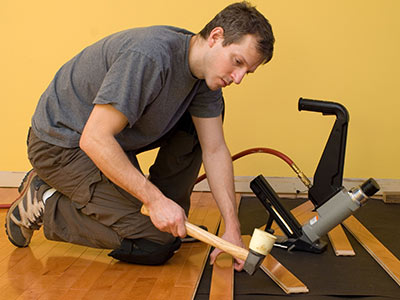Back to Flooring Products
How to Choose Between Solid Wood and Engineered Wood Flooring
Real wood floors are all so wonderful and having one installed in your home is a great idea. However, the market nowadays offers a plethora of options and types of real wood flooring. Naturally, the main consideration and dilemma will be between solid wood flooring and engineered wood flooring as two of the most popular and well-loved types of flooring nowadays.
Indeed, both of them have their advantages and benefits, but both of them could also offer some disadvantages, it all depends on whether or not you choose the right type of flooring for your project and objectives. So if you are wondering which options offer the best value, in this case, let’s find out a bit more about solid wood and engineered wood flooring and compare them in order to help you make the best choice for your home.
Solid Wood Or Engineered Wood Flooring – Differences
 Indeed, solid wood and engineered wood floors may look pretty much like the same thing when installed. However, there is a major difference in their structures, which also impacts their installation and maintenance. Solid wood floors are pretty simple and self-explanatory, with floorboards cut entirely from one piece of timber. This is as close to real wood flooring as you can get. However, because of their simple structure, solid wood floors tend to be prone to the impact of humidity, moisture, and temperature fluctuations.
Indeed, solid wood and engineered wood floors may look pretty much like the same thing when installed. However, there is a major difference in their structures, which also impacts their installation and maintenance. Solid wood floors are pretty simple and self-explanatory, with floorboards cut entirely from one piece of timber. This is as close to real wood flooring as you can get. However, because of their simple structure, solid wood floors tend to be prone to the impact of humidity, moisture, and temperature fluctuations.
As a result, of their porous structure, solid wood floorboards tend to contract, expand and shrink when affected by excessive moisture, humidity, and temperature fluctuations. This can lead to a number of damages and quick wear and tear of the floor. In order to prevent this risk and still be able to offer the beauty of authentic wood to homeowners, engineered wood floors are designed. They are man-made products out of real wood materials and products. Engineered wood floorboards come with a specific structure of layers. The core of the floorboard is created out of layers of softwood, plywood, or other wooden products that are glued together and crisscrossed.
The core is then topped with a layer of hardwood. This specific structure ensures that moisture and humidity won’t affect the floorboards to such an extent, therefore engineered wood floors can be installed also in rooms like the bathroom, kitchen, and even the basement. Both engineered wood and solid wood floors can be re-sanded and refinished. However, in the case of engineered wood flooring, this can happen up to a couple of times in their lifespan, because the top hardwood layer is not that thick. On the contrary, solid wood floors are thicker and high-quality ones can be sanded up to 5-6 times in their lifespan.
Consider Where Do You Want to Install the Floor?
 Whether you would choose solid wood or an engineered wood floor depends a lot on where you want to install the floor. Solid wood floors look amazing and they add elegance wherever they are laid. Solid wood floors are a perfect choice for the living room or bedroom because they can easily make a statement and become the focal point of the room in terms of interior style.
Whether you would choose solid wood or an engineered wood floor depends a lot on where you want to install the floor. Solid wood floors look amazing and they add elegance wherever they are laid. Solid wood floors are a perfect choice for the living room or bedroom because they can easily make a statement and become the focal point of the room in terms of interior style.
However, solid wood floors are not the best option for rooms with higher moisture content, humidity, or temperature fluctuations. There is no time and place for worries because in these rooms you can still enjoy the beauty and elegance of wood flooring. Simply choose engineered wood flooring for the kitchen, bathroom, and basement. In addition, engineered wood floors are very durable and resistant to high traffic and heavy footfall, therefore they are also a great option for the hallway and even for wooden staircases.
Engineered wood floors also look great over underfloor heating systems and installed on top of subfloors that cannot be completely levelled and even for some reason.
Long-Lasting Power and Flexibility
Real wood flooring, no matter if solid wood or engineered wood, may seem like quite an investment at first. However, considering the fact that real wood flooring increases the value of the property and that you can enjoy a hardwood floor for up to a whole century if you maintain it properly, you will quickly understand that real wood floors actually ensure the return of investment and are worth every penny. It only makes sense to choose the right wooden floor type for your project, property and its specifics and install this floor that will last decades.
High-quality solid wood floors that are installed properly and by professionals and maintained properly and regularly are designed to last for a whole century and even younger. It will be generations until there is a need to replace the good old floor. Re-sanding and refinishing it ensure the floor will look brand-new even after years of everyday use. Engineered wood floors, on another hand, have a thinner hardwood layer, which means they cannot be re-sanded that many times and they are not as long-lasting as a solid wood floor. However, an engineered wood floor will still last for decades until there is a need to replace it.